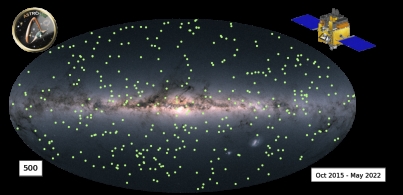
Positions of all 500 Gamma Ray bursts detected by AstroSat CZTI. (Image credit: AstroSat CZTI team / Aswin Suresh, Gaurav Waratkar, Varun Bhalerao (IIT Bombay). The background is an optical view of the night sky (Background image credit: ESA/Gaia/DPAC)
PUNE (PTI): AstroSat, India's first dedicated astronomy mission which is in space since 2015, has detected the birth of a black hole for the 500th time, Pune-based research institution IUCAA has said, a development scientists termed as a “remarkable achievement”.
Black holes are objects with a gravitational pull so strong that not even light can escape. They are the subjects of intense scrutiny from astronomers from all over the world. Scientists across the world are studying their formation.
One way of forging black holes is the deaths of massive stars in Gamma Ray Bursts so powerful that they have been called mini big-bangs . They send intense jets of light and high-energy radiation shooting across the universe.
Another way to create Gamma-ray Bursts (GRBs) is the collision of two neutron stars – the kind of events that generate gravitational waves. Astronomers study the Gamma-rays and X-rays from such bursts to better understand explosion and black hole formation.
Launched in September 2015 by the Indian Space Research Organisation (ISRO), AstroSat is one of the most sensitive space telescopes in the world comprising five instruments that can simultaneously study the Universe in ultraviolet, optical, and X-ray radiation.
"One of these instruments is the Cadmium Zinc Telluride Imager (CZTI) - which has just witnessed the birth of a black hole for the five hundredth time," the Inter-University Centre for Astronomy and Astrophysics (IUCAA) said in a statement.
"This is a landmark achievement," said Prof Dipankar Bhattacharya of Ashoka University and IUCAA, who is the current Principal Investigator of CZTI.
The wealth of data obtained by CZTI on Gamma Ray Bursts is making a big impact worldwide, he added.
CZTI has been studying GRBs since it first opened its eyes 6.5 years ago.
The very first scientific result from AstroSat was the detection of GRB 151006A: just hours after the instrument was powered on after launch, said Prof. Varun Bhalerao, who leads the GRB search effort.
A unique aspect of CZTI is the ability to measure the polarisation of X-rays: an ability that is lacking in flagship missions like NASA's Neil Gehrels Swift Telescope or the US-Europe Fermi Space Telescope.
Tanmoy Chattopadhyay, of the US-based Stanford University, has played a key role in these polarisation studies.
Polarisation tells us what is happening just outside the newly-formed black hole. It is the most important measurement to distinguish between different theories of Gamma-ray bursts, said Chattopadhyay.
 Previous Article
Previous Article













The Indian Air Force, in its flight trials evaluation report submitted before the Defence Ministry l..
view articleAn insight into the Medium Multi-Role Combat Aircraft competition...
view articleSky enthusiasts can now spot the International Space Station (ISS) commanded by Indian-American astr..
view article